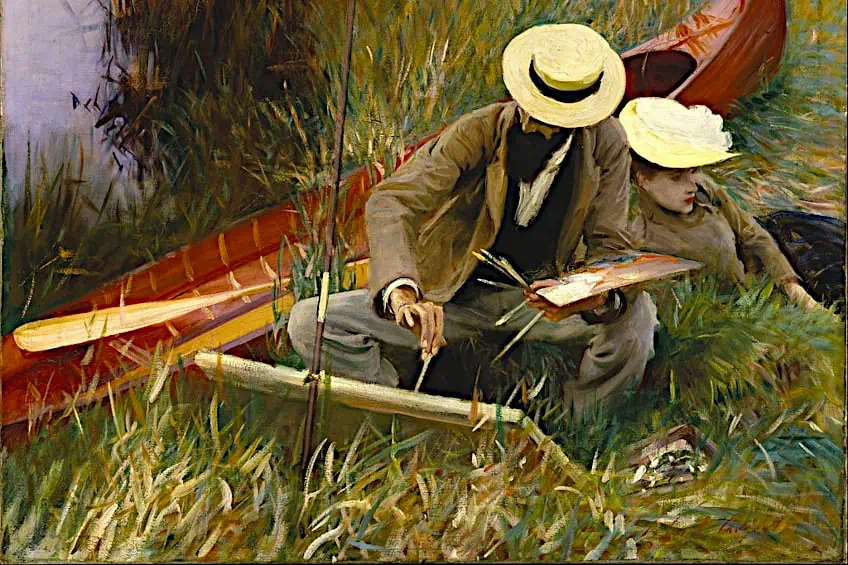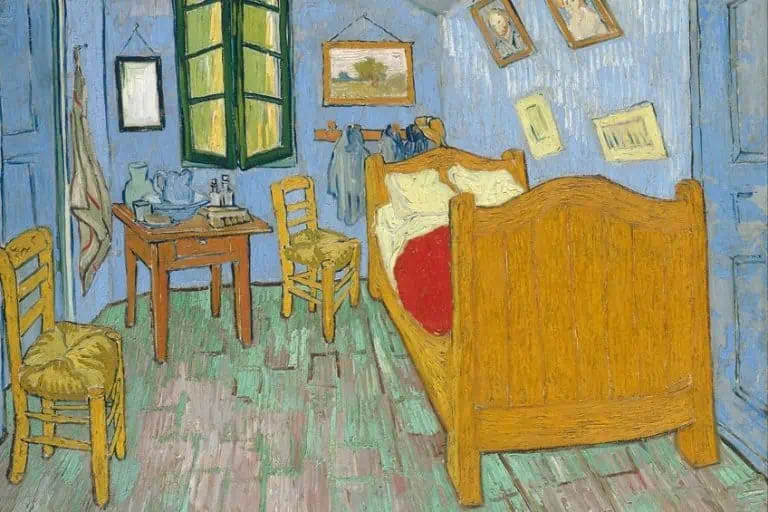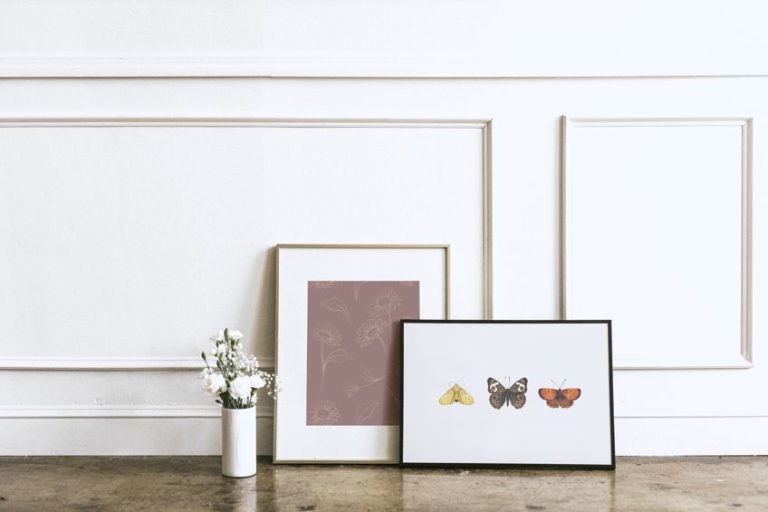Texture in Art – How Artists Create and Use Surface Quality
This post may contain affiliate links. We may earn a small commission from purchases made through them, at no additional cost to you.
What is the texture art definition, and are there texture art examples? Texture in art refers to the perceived or real surface quality of an artwork. Texture in painting and other visual arts is sometimes incorrectly labeled as one of the principles of art, but along with line, space, value, form, and color, we place texture in the “elements of art” category. With a better understanding of texture in elements of art, artworks become more alive and interesting to the eye.
Table of Contents
Understanding Texture in Art
Texture in art is a two-dimensional and three-dimensional design element that stands out due to its observed physical and visual qualities. Texture art examples can refer to works with actual physical textures that were added to the artwork’s surface or the visual texture of the subject matter within an artwork. Let us explore Physical and visual texture in more detail.
Physical Texture
The tactile aspects of an artwork that can be tangibly touched or felt are referred to as physical texture in art. In art, physical texture is produced by using materials and processes that provide a specific quality to a surface, such as furriness, smoothness, hardness, or roughness.
 Still Life with Anchovies by Antonio Sicurezza (1972); Antonio Sicurezza, Public domain, via Wikimedia Commons
Still Life with Anchovies by Antonio Sicurezza (1972); Antonio Sicurezza, Public domain, via Wikimedia Commons
Physical texture can be created by artists in a number of different ways.
One approach is to cover a surface with thickly applied layers of paint as well as other materials. As the texture emerges from the surface, it can produce a three-dimensional effect. Another approach is to produce textures in the material with tools like palette knives, brushes, or other objects.
Material Texture
Physical texture in artworks can also easily be achieved using a range of materials. Sculptures, for instance, can be made from materials with distinct textures, such as wood, stone, or metal. To add physical texture to their work, artists often use a range of materials such as cloth, paper, or natural elements like leaves or butterfly wings.
Physical texture often adds depth and intrigue to an artwork while also enhancing the viewer’s sensory experience.
 Detail from the Ecstasy of St. Theresa by Gian Lorenzo Bernini (1647-1652); Benjamín Núñez González, CC BY-SA 4.0, via Wikimedia Commons
Detail from the Ecstasy of St. Theresa by Gian Lorenzo Bernini (1647-1652); Benjamín Núñez González, CC BY-SA 4.0, via Wikimedia Commons
Physical texture can additionally be utilized in artwork to portray a certain feeling or mood, such as roughness to suggest anxiety or smoothness to represent relaxation. By adding physical textures, you can create more realistic art or even textured Abstract art.
Light is a key aspect in establishing physical texture since it influences how a surface is perceived. Bright lighting on a smooth surface might impede the clarity of a sketch or image, yet it can produce striking contrasts on a very textured surface like river stones, glass, and so on.
As an example, x-ray analysis of Johannes Vermeer’s View of Delft (1659-1661) revealed that he mixed sand into the brown paint that he used to represent the buildings, to simulate the rough textures of brick and stone.
 Detail of A View of Delft by Johannes Vermeer (1659-1661); Johannes Vermeer, CC BY 3.0, via Wikimedia Commons
Detail of A View of Delft by Johannes Vermeer (1659-1661); Johannes Vermeer, CC BY 3.0, via Wikimedia Commons
Visual Texture
The appearance of the physical texture in paintings is created by implied texture or visual texture. Implied textures are simulated differences between the surfaces of represented objects. Artists use a range of representational and technical methods to represent such diverse textures as fur, water, wood, stone, etc.
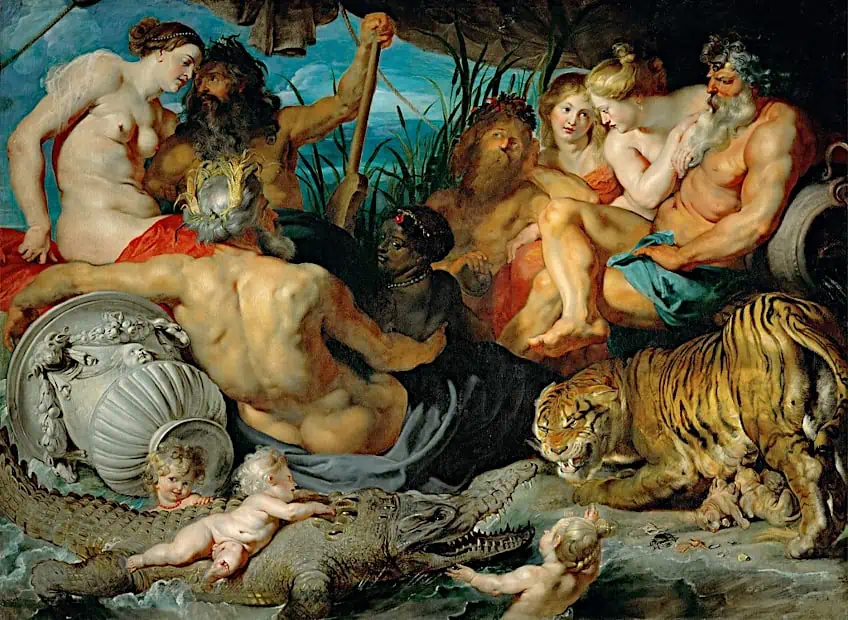 The Four Continents by Peter Paul Rubens (c. 1615); Peter Paul Rubens, Public domain, via Wikimedia Commons
The Four Continents by Peter Paul Rubens (c. 1615); Peter Paul Rubens, Public domain, via Wikimedia Commons
Every substrate used in art has its own visual texture that must be considered before designing a composition. As a result, materials like watercolor paper and canvas are much rougher than photo-quality paper and might be ideal for achieving rough textures, but may not be suitable for generating a smooth, flat texture.
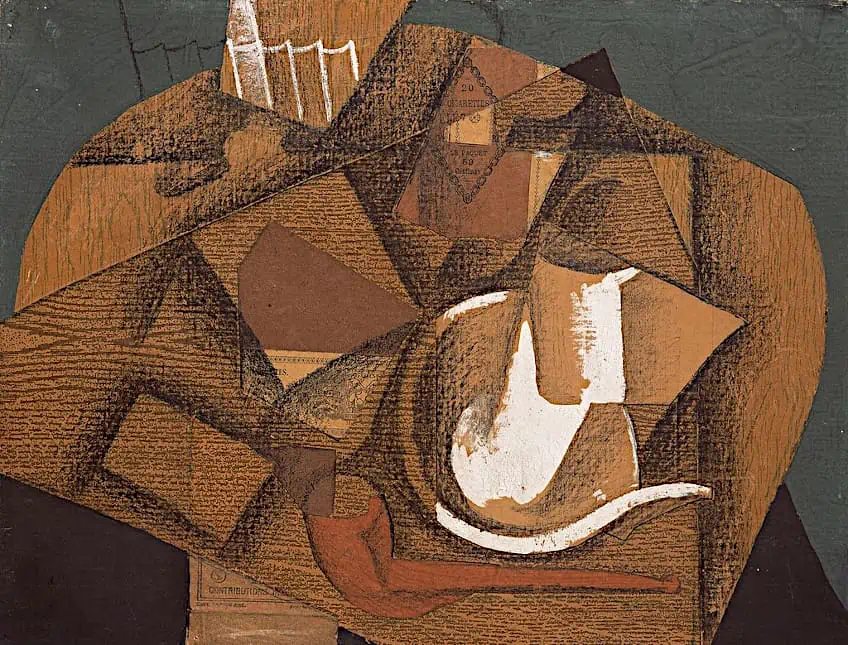 Mug and Pipe by Juan Gris (1914); Juan Gris, Public domain, via Wikimedia Commons
Mug and Pipe by Juan Gris (1914); Juan Gris, Public domain, via Wikimedia Commons
Photographs, sketches, and paintings all employ visual texture to depict their subjects accurately and creatively. The texture is often produced in various media by repeating the form and line.
Decorative Texture
Decorative texture is a form of visual texture that is made with the objective of increasing visual interest or improving the aesthetic value of a surface. It is frequently used in decorative arts, textiles, and crafts.
Embossing, stamping, and engraving are all methods that can be employed to produce decorative textures.
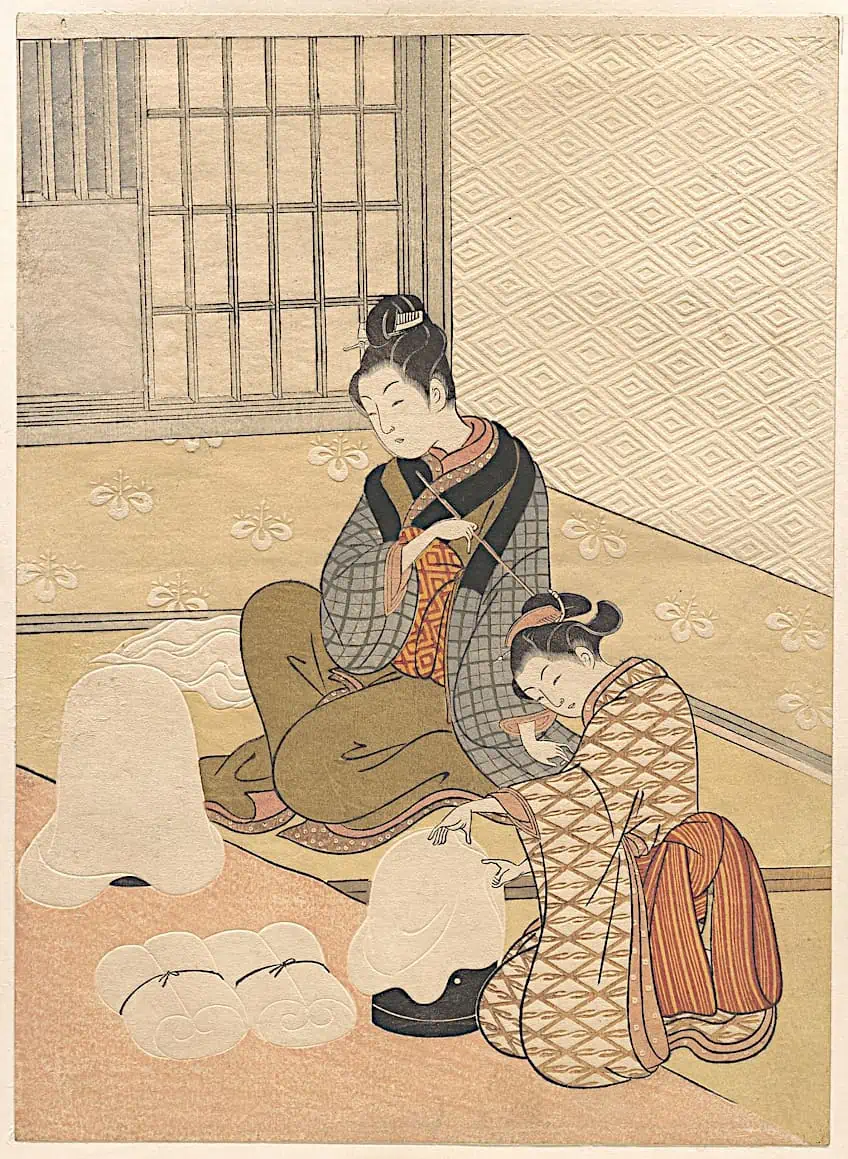 Evening Snow on the Heater embossed print by Suzuki Harunobu (late 18th Century); Suzuki Harunobu, CC0, via Wikimedia Commons
Evening Snow on the Heater embossed print by Suzuki Harunobu (late 18th Century); Suzuki Harunobu, CC0, via Wikimedia Commons
Nature is frequently repetitive, and it might include a pattern that repeats over the surface. This texture is typically designed to add beauty or intrigue to an object, as opposed to expressing a specific meaning.
Spontaneous Texture
A spontaneous texture is a texture that occurs in an unexpected or spontaneous manner. It is commonly produced using techniques that let the artist work freely, such as pouring or splattering paints over a surface. The employment of tools like palette knives, which provide more expressive and unexpected markings, can also be utilized to produce spontaneous texture.
This texture is frequently employed in textured abstract art, where the emphasis is on the expressive aspects of the painting instead of accuracy or realism.
 Untitled by Cy Twombly (1957); Pedro Ribeiro Simões from Lisboa, Portugal, CC BY 2.0, via Wikimedia Commons
Untitled by Cy Twombly (1957); Pedro Ribeiro Simões from Lisboa, Portugal, CC BY 2.0, via Wikimedia Commons
Mechanical Texture
Mechanical texture in art relates to the portrayal of man-made or machine-created textures. These textures can also include patterns and surfaces seen in wood, metal, cloth, or any other human-crafted or created object. Another example is photography, where the grain pattern used in printing generates texture on the surface. The Pop Artist Roy Lichtenstein mimicked the mechanical texture created by the printing methods used for comics. Designs in computer graphics and typography are also examples of this.
 Kiss V by Roy Lichtenstein (1964); Myosotis alpestre, CC BY-SA 4.0, via Wikimedia Commons
Kiss V by Roy Lichtenstein (1964); Myosotis alpestre, CC BY-SA 4.0, via Wikimedia Commons
Best Mediums to Use to Create Textures
To produce physical texture in a painting, artists typically employ thicker, more viscous media that keep their shape after drying. Oil paints, thick-body acrylic paints, and wax—either cold or encaustic wax – are wonderful examples of materials that can generate physical texture on the canvas’s surface. Oil paint dries gradually, and painting in heavy layers might take months to completely dry and set.
 An Out-of-Doors Study by John Singer Sargent (1889); John Singer Sargent, Public domain, via Wikimedia Commons
An Out-of-Doors Study by John Singer Sargent (1889); John Singer Sargent, Public domain, via Wikimedia Commons
The answer is to incorporate an oil paint medium into the paint mixture. A solution like Liquin Impasto applied to the paint helps speed up the drying process.
If you let the paint cure and set faster, it will be possible to hang it on the wall sooner. To achieve the visual impression of texture, you can use any type of paint or drawing material. Watercolors, for instance, can be used to give the effect of feathers, fur, and leaves on trees, or grass. Dry-brush painting is an excellent way to create the appearance of texture with any type of paint. You might also use a fine brush and watery paint to define single brush strokes to portray grass forms, such as oil paint combined with gouache or linseed oil.
Texture Art Examples
The best way to get a good understanding of this element of art is to look at some texture artwork examples. Some will be examples of visual texture and others of physical texture. Some will even be good examples of both.
Starry Night (1889) by Vincent van Gogh
| Artist | Vincent van Gogh (1853 – 1890) |
| Date Completed | 1889 |
| Medium | Oil on canvas |
| Dimensions (cm) | 74 x 92 |
| Location | The Museum of Modern Art, New York City, United States |
Van Gogh used texture in several methods to produce a vibrant and immersive setting. The thickly applied impasto strokes he employed to achieve the swirling patterns in the sky are one of the artwork’s most remarkable applications of texture. These broad strokes evoke the whirling winds and stars of the night sky, producing a sense of motion and intensity.
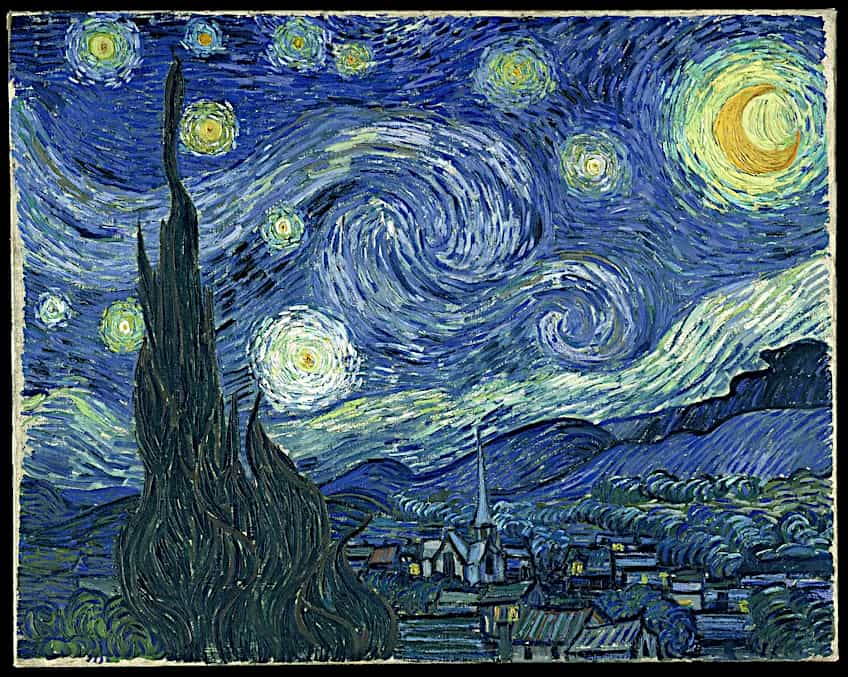 The Starry Night by Vincent van Gogh (1889); Vincent van Gogh, Public domain, via Wikimedia Commons
The Starry Night by Vincent van Gogh (1889); Vincent van Gogh, Public domain, via Wikimedia Commons
The thickness of the brushstrokes adds depth and richness to the three-dimensional surface created by the layers of paint.
Van Gogh also used texture in his paintings to add contrast and variation. The strong, heavier strokes of the sky contrast with the finer, more delicate strokes employed to form the foreground hamlet and trees. This produces visual balance and intrigue by drawing the observer’s attention from the background to the foreground and back again.
The Thinker (1902) by Auguste Rodin
| Artist | Auguste Rodin (1840 – 1917) |
| Date Completed | 1902 |
| Medium | Bronze |
| Dimensions (cm) | 185 (height) |
| Location | Musée Rodin, Paris, France |
Rodin incorporated texture in this artwork in a variety of ways, including his manipulation of the sculpture’s surface. The figure’s bronze surface is rough and irregular, with noticeable ridges and protrusions evoking the roughness and intricacy of the human body. The texture of the bronze contributes to the emotional effect of the sculpture by providing a sense of body and presence that pulls the observer into the figure’s introspective posture.
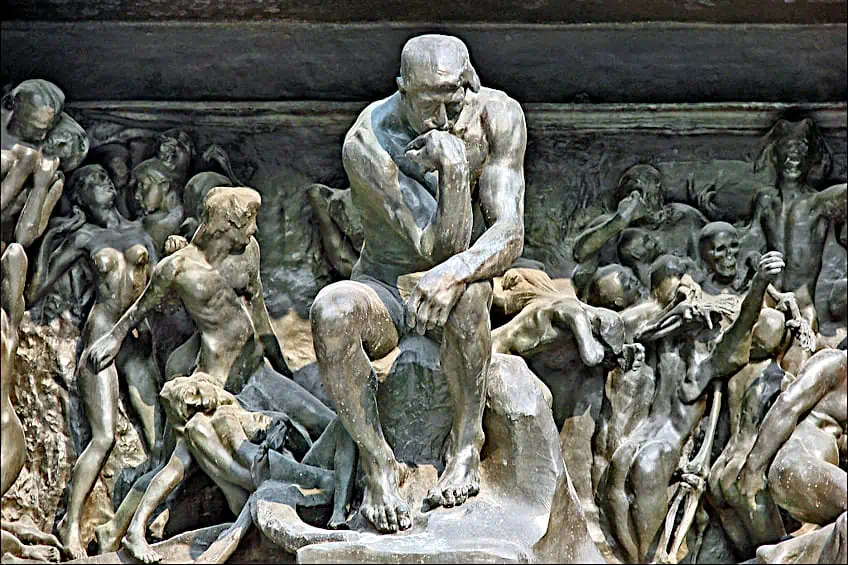 The Thinker on The Gates of Hell by Auguste Rodin (1890); Jean-Pierre Dalbéra from Paris, France, CC BY 2.0, via Wikimedia Commons
The Thinker on The Gates of Hell by Auguste Rodin (1890); Jean-Pierre Dalbéra from Paris, France, CC BY 2.0, via Wikimedia Commons
Rodin employed an ancient process known as “lost wax” to produce the sculpture’s extremely detailed and expressive surface.
A detailed wax model of the figure was created, which was then covered in clay and baked in a kiln. The kiln’s heat dissolved the wax, resulting in a hollow mold that could be loaded with molten bronze. The clay mold was stripped away once the bronze had solidified and cooled to expose the final sculpture.
Black Iris III (1926) by Georgia O’Keeffe
| Artist | Georgia O’Keeffe (1887 – 1986) |
| Date Completed | 1926 |
| Medium | Oil on canvas |
| Dimensions (cm) | 91 x 75 |
| Location | The Metropolitan Museum of Art, New York City, United States |
In this famous painting, O’Keeffe also employed texture to create contrast and variation. The sleek, glossy texture of the leaves and stem contrasts with the soft, velvet surface of the petals. When the eye goes from one texture to another, this gives a feeling of visual interest and balance. The delicate, exact brushwork and rich hues provide an impression of delicacy and intimacy, while the intricate patterns on the surface allude to the natural world’s complexities and beauty. The artwork exemplifies O’Keeffe’s mastery of texture as well as her ability to produce evocative, immersive paintings.
She created the luscious, tactile texture of the petals using tiny, delicate brushstrokes in deep tones of black and gray. The brushstrokes provide depth, evoking the folds and wrinkles of the iris’ petals.
Number 1A, 1948 (1948) by Jackson Pollock
| Artist | Jackson Pollock (1912 – 1956) |
| Date Completed | 1948 |
| Medium | Oil and enamel on canvas |
| Dimensions (cm) | 172 x 264 |
| Location | The Museum of Modern Art, New York City, United States |
Pollock’s method of splattering paint onto the canvas to generate rich, layered surfaces is key to this piece. Pollock’s particular application of paint was one of the primary ways he employed texture in this artwork. Instead of creating by applying paint to the canvas with a brush, Pollock utilized a variety of instruments to drip and spatter the paint in an apparently random pattern. This resulted in a rich, varied surface with lots of texture and aesthetic appeal.
Layers of paint accumulate on the canvas, resulting in a visually and physically tactile surface. Its texture adds a sense of weight and materiality to the artwork as if the paint is exploding off the canvas and into the viewer’s environment.
Woman I (1952) by Willem de Kooning
| Artist | Willem de Kooning (1904 – 1997) |
| Date Completed | 1952 |
| Medium | Oil paint, graphite, crayon, and pastel on canvas |
| Dimensions (cm) | 193 x 147 |
| Location | The Museum of Modern Art, New York City, United States |
Texture is important in this artwork since de Kooning’s approach entailed utilizing broad, expressive brushstrokes to produce an intricate, layered surface with visual interest and emotional effect. De Kooning employed texture in a variety of methods, including his utilization of paint. He painted the canvas with heavy, impasto layers of paint, employing broad, flowing brushstrokes to give a feeling of movement and excitement.
The painting’s surface is dotted with ridges, bumps, and valleys, alluding to the various features of the feminine body.
The artist also applied texture to provide depth and complexity to the painting. Layers of paint accumulate on the canvas, resulting in a visibly and practically tactile surface. The paint texture is visible in how the colors merge and overlap.
Elements of Art Overview
That concludes our look at texture in painting and sculpture. Texture in elements of art refers to the real or perceived quality of the surface. This quality can appear smooth, rough, rippling, jagged, furry, and so on. Textures make artworks look like you can touch the details of the artwork, and texture artworks can appear almost three-dimensional.
Frequently Asked Questions
What Is the Texture Art Definition?
Texture in art is a significant art element that provides aesthetic appeal, as well as emotional intensity to a piece of art. Texture in artwork refers to an artwork’s tangible surface characteristics, such as its roughness, smoothness, or density. Texture is considered a tactile and visual art element that is frequently utilized to give a feeling of dimension and depth to a piece of art.
What Does Principles of Art Mean?
A collection of criteria or concepts that artists utilize to create aesthetically attractive and impactful works of art are referred to as art principles. These concepts may be used in all forms of visual art, from paintings and drawings to sculptures and photographs, and artists employ them to produce works that are both aesthetically appealing and thematically complex. The principles are contrast, unity, proportion, rhythm, movement, emphasis, and balance.
In 2005, Charlene completed her wellness degrees in therapeutic aromatherapy and reflexology at the International School of Reflexology and Meridian Therapy. She worked for a company offering corporate wellness programs for several years before opening her own therapy practice. In 2015, she was asked by a digital marketer friend to join her company as a content creator, and it was here that she discovered her enthusiasm for writing. Since entering the world of content creation, she has gained a lot of experience over the years writing about various topics such as beauty, health, wellness, travel, crafting, and much more. Due to various circumstances, she had to give up her therapy practice and now works as a freelance writer. Since she is a very creative person and as a balance to writing likes to be active in various areas of art and crafts, the activity at acrylgiessen.com is perfect for her to contribute their knowledge and experience in various creative topics.
Learn more about Charlene Lewis and about us.
